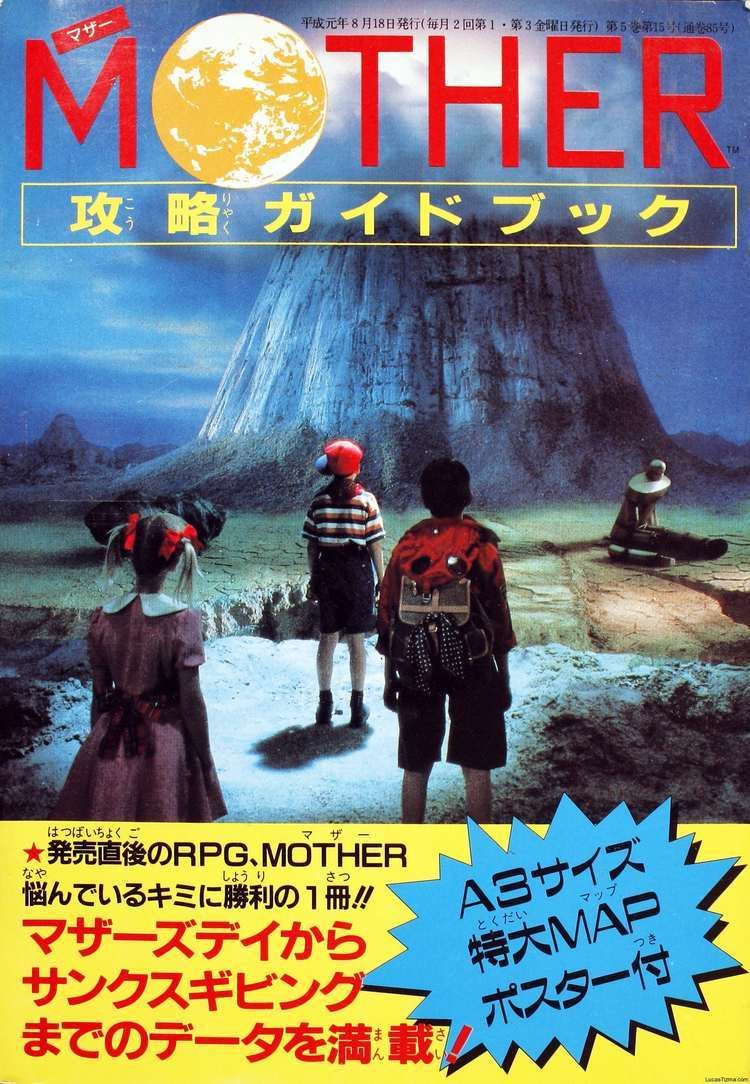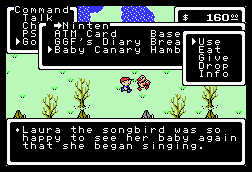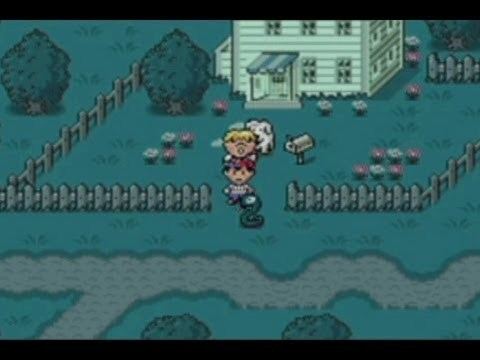Initial release date 27 July 1989 | Genre(s) Role-playing game Series Mother | |
 | ||
Programmer(s) Kazuya NakataniTakayuki OnoderaMotoo Yasuma Composer(s) Keiichi SuzukiHirokazu Tanaka Similar Mother games, Nintendo games, Role-playing video games | ||
Mother (Japanese: マザー, MOTHER), later released outside Japan as EarthBound Beginnings, is a role-playing video game developed by Ape and published by Nintendo for the Famicom. The game is modeled on the gameplay of the Dragon Quest series, but is set in the late 20th century United States, unlike its fantasy genre contemporaries. Mother follows the young Ninten as he uses his great-grandfather's studies on psychic powers to fight hostile, formerly inanimate objects and other enemies. The game uses random encounters to enter a menu-based, first-person perspective battle system. It is the first game in the Mother series and was followed by two sequels, EarthBound in 1994 and Mother 3 in 2006.
Contents

The game's writer and director, Shigesato Itoi, pitched the game concept to Shigeru Miyamoto while visiting Nintendo's headquarters for other business. Though Miyamoto denied the proposal at first, he eventually gave Itoi a development team. The game was released in Japan on July 27, 1989. A North American version was localized into English, but was abandoned as commercially nonviable. A copy of this prototype was later found and circulated on the Internet under the unofficial, fan-created title EarthBound Zero. The game was eventually released worldwide under the name EarthBound Beginnings for the Wii U Virtual Console on June 14, 2015.

Reviewers noted the game's similarities with the Dragon Quest series and its simultaneous parody of the genre's tropes. They considered the game's sequel, EarthBound, very similar and a better overall implementation of Mother's gameplay ideas. Critics also noted the game's high level of difficulty and issues of balance. Mother sold 150,000 copies and received a "Silver Hall of Fame" score from Japanese reviewer Weekly Famitsu. Jeremy Parish of 1UP.com wrote that Mother importantly generated interest in video game emulation and the historical preservation of unreleased games. The game was later rereleased in Japan on the single-cartridge compilation Mother 1+2 for the Game Boy Advance in 2003.

Gameplay

Mother is a single-player, role-playing video game set in a "slightly offbeat", late 20th century United States as interpreted by Japanese author Shigesato Itoi. The game eschews traits of its Japanese role-playing game contemporaries: it is not set within the fantasy genre and only enters science fiction for its final sequence. The player fights in warehouses and laboratories instead of in standard dungeons. Instead of swords, assault weapons, and magic, the player uses baseball bats, toy guns, and psychic abilities. The game's protagonist, Ninten, is about 12 years old.

Like the Dragon Quest series, Mother uses a random encounter combat system. The player explores the overworld from a top-down perspective and occasionally enters a first-person perspective battle sequence where the player chooses attack options from a series of menus. On their turn, the player selects between options to fight, guard, check enemy attributes, run away, use items, or use offensive, defensive, or healing psychic powers. The player can also set the battle on autopilot with the "auto" option. Critical hits register with the series' signature "SMAAAASH" text and sound.
The player can press a button to have Ninten "check" or "talk" with nearby people, animals, and objects. The game shares similarities with its sequel, EarthBound: there is a game save option through using a phone to call Ninten's father, an option to store items with Ninten's sister at home, and an automated teller machine for banking money. The members of Ninten's party are all visible on the overworld screen at once, and are analogous to EarthBound's party members in style and function. Mother's world map does not keep locations separate, and instead connects all areas (akin to the Pokémon series games). The game's story begins as Ninten discovers a music box and receives the journal of his great-grandfather, who studied psychic powers nearly a century earlier. Ninten is attacked by household items, and ventures outside to find a crazy world with hostile everyday objects and other odd events.
Plot
Mother begins with the story of a young, married, American couple who mysteriously vanish from their small, rural town. Two years later, the husband, George, returned as mysteriously as he vanished, and began a strange study in complete seclusion. His wife, Maria, was never heard from again. Years later, in the late 1980s, a young American boy named Ninten is attacked at home in a paranormal event. His father explains that Ninten's great-grandfather studied psychic powers, and asks Ninten to investigate a crisis occurring across the world, the work of an invading alien race. After finishing a few tasks, Ninten is warped to the world of Magicant, where the land's ruler, Queen Mary, asks Ninten to find her song, the Eight Melodies, and play them for her. Ninten returns to Earth and befriends a young boy, Lloyd, who is being teased at an elementary school. The two travel to the town of Snowman to deliver a lost hat to Ana, a young girl with psychic powers. Ana tells Ninten she saw him in a dream, and joins the party in hopes of finding her missing mother.
After finding most of the Melodies, Ninten is harassed at a karaoke bar by Teddy, the boss of a local gang. Teddy surrenders after losing to Ninten in a duel, and joins Ninten's party with the intent to avenge the deaths of his parents, who were killed at Holy Loly Mountain. Lloyd stays behind. In a cottage at the base of Holy Loly Mountain, Ana pulls Ninten aside and asks him to be with her always. The two dance and profess their mutual love. When about to leave, the party is attacked by a powerful robot that knocks out the entire party. Lloyd arrives with a tank and destroys the robot, but accidentally attacks the party and critically wounds Teddy, so Lloyd rejoins the party. They take a boat out on Holy Loly Lake and a whirlpool pulls them into an underwater laboratory where they find a robot who claims to have been built by George to protect Ninten. When the laboratory floods, they leave for the mountain and the robot helps them ascend. On the way, they find a cave with human prisoners including Ana's mother. They need to defeat the Mother Ship to free the prisoners. Another robot attacks at the summit, and George's robot is sacrificed in the struggle. Ninten learns the final melody at the mountain's summit. The party is warped to Magicant, where Ninten sings the Eight Melodies to Queen Mary. She recalls the rest of the song and reminisces about an alien named Gyiyg that she loved as her own child. Queen Mary reveals that she is George's wife, Maria, and vanishes. Magicant, a mirage created by her conscience, vanishes with her.
The party is warped back to the top of Holy Loly Mountain, where the party discovers George's grave. Large rocks block the entrance to a cave inside Holy Loly Mountain, but are cleared by the power of Maria's conscience. The party encounters the Mother Ship and a fluid-filled tank that contains Gyiyg. The alien expresses its gratefulness to Ninten's family for raising it, but explains that George stole vital information from its people that could have been used to betray them, and proceeds to accuse Ninten of interfering with their plans. Gyiyg offers to save Ninten alone if he boards the Mother Ship. When Ninten declines, Gyiyg attempts to put Ninten to sleep. The party begins to sing the Eight Melodies while Gyiyg tries to quiet the party through an attack. When the party finishes the lullaby, Gyiyg is overcome with emotion at the thought of Maria's motherly love. Gyiyg says they will meet again and flies off in the Mother Ship. The game ends with Ninten, Ana, and Lloyd facing the player as the credits roll behind them.
Development
Mother was developed by Ape and published by Nintendo. While visiting Nintendo for other work, copywriter Shigesato Itoi pitched his idea for a role-playing game set in contemporary times to the company's Shigeru Miyamoto. He thought the setting would be unique for its incongruence with role-playing genre norms, as daily life lacked the pretense for magic powers and they could not simply give the child characters firearms as weapons. Itoi's project proposal suggested how the natural limitations could be circumvented. Miyamoto met with him and praised the idea, though he was not sure whether Itoi "could pull it off". As an advertiser, Itoi was used to concept proposals preceding the staffing process, but Miyamoto explained that video game concepts needed people who signed on to "make" the product. Itoi was overcome with "powerlessness".
Miyamoto was also hesitant to work with Itoi at a time when companies were pushing major celebrity product endorsements, as Itoi's involvement would be for such a game. When the two met next, Miyamoto brought the documentation from a text adventure game and told Itoi that he would have to write similar documentation himself. Miyamoto said that he knew from his own experience that the game would only be as good as the effort Itoi invested, and that he knew Itoi could not invest the appropriate time with his full-time job. Itoi restated his interest and reduced his workload, so Miyamoto assembled a development team. Upon assessing for compatibility, they began production in Ichikawa, Chiba. Itoi had said earlier that he wanted his work environment to feel like an extracurricular club consisting of volunteers and working out of an apartment, which Miyamoto tried to accommodate. Itoi wrote the game's script and commuted from Tokyo, a process he found "exhausting". Even with asking Itoi to prioritize the development process, Miyamoto received criticism of acquiescing to celebrity and of hiring a copywriter not up for the task. Miyamoto said that his decision to pursue the project was based on his confidence in Itoi. Mother was released in Japan on July 27, 1989 for the Famicom (known as the Nintendo Entertainment System outside Japan).
English-language release
The game was scheduled for localization into the English language for a North American release as Earth Bound, but was abandoned when the team chose to localize Mother 2 instead. Critics noted in retrospect that the game's release would have been a waste of money if launched as planned alongside the acclaimed Final Fantasy III on an outdated console in a "niche" genre. Years later, a version of the completed, original Mother localization was found. The cartridge was auctioned and uploaded to the Internet, where it unofficially became known as EarthBound Zero. The unreleased localization featured tweaks to the original Japanese version. On June 14, 2015, before the Nintendo World Championships, Nintendo released the much-awaited official English version of Mother, with the title EarthBound Beginnings, on the Wii U Virtual Console in North America and Europe.
Music
The game's soundtrack was composed by Keiichi Suzuki and Hirokazu Tanaka. Tanaka was a video game composer working for Nintendo who had previously composed for games such as Super Mario Land and Metroid, while Suzuki was a composer and musician for bands of many different genres. The NES was only able to play three notes at a time, which Suzuki has noted greatly limited what he was able to produce, as he could not create some of the sounds he wanted.
An eleven-track album of songs inspired by the game's soundtrack was recorded in Tokyo, London, and Bath and released by CBS/Sony Records on August 21, 1989. The album contained mostly vocal arrangements in English and was likened by RPGFan reviewer Patrick Gann to compositions by the Beatles and for children's television shows. He found the lyrics "cheesy and trite" but appreciated the "simple statements" in "Eight Melodies" and the "quirky and wonderful" "Magicant". Only the last song on the album is in chiptune. Gann ultimately recommended the 2004 remastered release over this version. The game's soundtrack contains several tracks later used in subsequent series games.
Reception and legacy
Mother received a "Silver Hall of Fame" score of 31/40 from Japanese reviewer Weekly Famitsu. Reviewers noted the game's similarities with the Dragon Quest series and its simultaneous "parody" of the genre's tropes. They thought the game's sequel, EarthBound, to be very similar and a better implementation of Mother's gameplay ideas. Critics also noted the game's high difficulty level and balance issues. Mother sold 150,000 copies.
Jeremy Parish of USgamer described the game as a mild-mannered parody ("between satire and pastiche") of the role-playing game genre, specifically the Dragon Quest series. He noted that Mother, like many Japanese role-playing games, emulated the Dragon Quest style: the windowed interface, first-person perspective in combat, and graphics, but differed in its contemporary setting and non-fantasy story. Parish commented that Atlus's 1987 Digital Devil Story: Megami Tensei was similarly set in the modern day, though it devolved into science fiction and fantasy in ways Mother did not. He added that the game has "a sense of wonder and magic realism ... in the context of childhood imagination" as Ninten can feel more like someone "pretending" to be a Dragon Quest-style hero than a hero in his own right. Parish said this makes the player wonder which game events are real and which are Ninten's imagination. Parish cited Itoi's interest in entering the games industry to make a "satirical" role-playing game as proof of the genre's swift five-year rise to widespread popularity in Japan.
Cassandra Ramos of RPGamer praised the game's graphics and music, and considered it among the console's best, with "rich, ... nicely detailed" visuals, Peanuts-style characters, and "simple but effective" audio. In contrast, she found the battle sequences aesthetically "pretty bland" and, otherwise, the game's "least interesting" aspect. Overall, she found Mother "surprisingly complex ... for its time", and considered its story superior to (but less "wacky" than) its sequel. She especially recommended the game for EarthBound fans.
Parish credited Itoi for the game's vision and compared his ability and literary interests with American author Garrison Keillor. Parish felt that Itoi's pedigree as a writer and copywriter was well suited for the space-limited, 8-bit role-playing game medium, which privileged Mother ahead of other games written by non-writers. USgamer's Parish noted how the game's non-player characters would "contemplate the profound and trivial" instead of reciting the active plot. He added that the game's lack of an official North American release has bolstered the reputation and revere of its immediate sequel.
While Parish said Mother's script was "as sharp as EarthBound's", he felt that the original's game mechanics did not meet the same level of quality. Mother lacked the "rolling HP counter" and non-random encounters for which later entries in the series were known. Parish also found the game's balance to be uneven, as the statistical character attributes and level of difficulty scaled incorrectly with the game's progression. Rose Colored Gaming, a company that made custom reproductions of the NES cartridge, noted that the Japanese release's was more challenging than the unreleased English localization. RPGamer's Ramos similarly found balance issues, with a high amount of battles, difficult enemies, reliance on grinding, and some oversized levels. Parish wrote earlier for 1UP.com that in comparison to EarthBound, Mother is "worse in just about every way", a clone where its sequel was "a satirical deconstruction of RPGs". He wrote that the game's historical significance is not for its actual game but for the interest it generated in video game emulation and the preservation of unreleased games.
Mother was rereleased in Japan as the single-cartridge Mother 1+2 for the Game Boy Advance in 2003. This version uses the extended ending of the unreleased English prototype, but is only presented in Japanese. Starmen.net hosted a Mother 25th Anniversary Fanfest in 2014 with a livestream of the game and plans for a remixed soundtrack. Later that year, fans released a 25th Anniversary Edition ROM hack that updated the game's graphics, script, and gameplay balance.
In April 2016, a film group known as 54&O Productions announced a Kickstarter campaign to secure funds for a fan-made documentary entitled Mother to Earth. The documentary will focus on the road to Mother's localization in North America, and will include interviews with key people behind the process. After the success of the Kickstarter campaign, the documentary is set to be released around December 2018.
